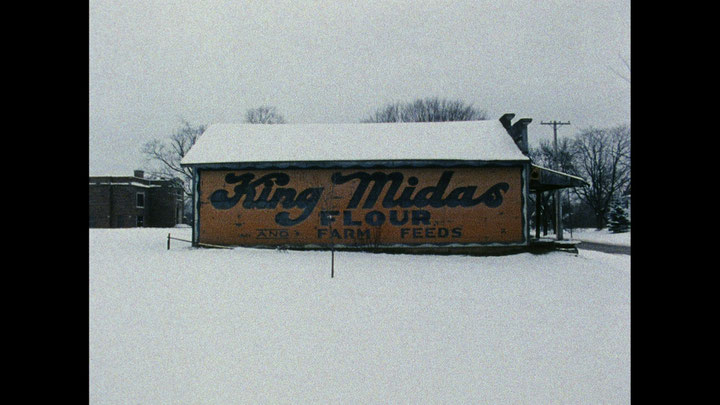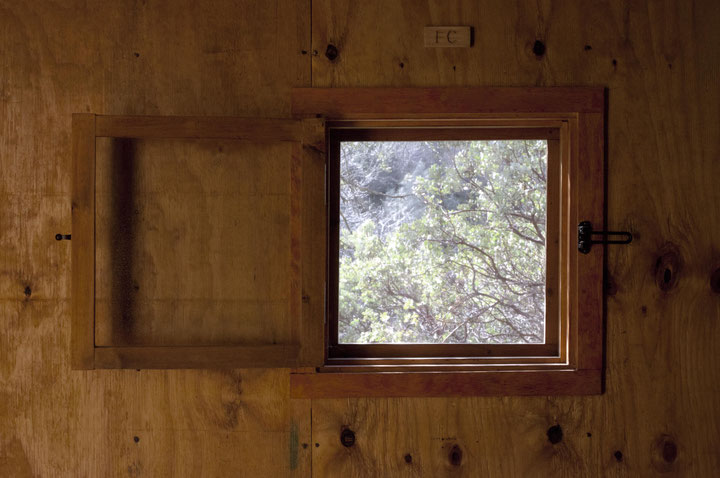Issue 1/2012 - Net section
Almost complete autonomy
An example of the freedoms afforded by digital production: US filmmaker James Benning
Do new means of production inevitably give rise to new forms of production? Do they extend the shelf-life of established approaches whilst improving their quality? Or do these new means perhaps barely perceptible tone down the intensity that was once attained? All these considerations appear to apply to a certain extent in the case of the filmmaker James Benning, who has created a highly diverse body of work on celluloid since the late 1960s. On the whole, new ways of looking and new dispositives emerge with the shift to digital production; although these superficially appear to have a great deal in common with older approaches and dispositives, in fact these new modes are on the verge of breaking irrevocably with what went before. In 2008 Benning bought a Sony-EX3 digital camera; since then he has not only produced a host of short and longer works, as well as several installations, but is now also, as he puts it, revelling in the »cheaper way of working, complete autonomy and a system that’s a thousand times faster than before«.1 As audiences could see for themselves in a special screening series organised by the Austrian Film Museum in November 2011, Benning’s more recent films move in several directions simultaneously. He picks up on older projects, reworks them, yet at times leaves these behind and makes an utterly fresh start – striking a strange equilibrium between continuity and a new slant on particular models of film aesthetics.
Benning has been viewed over the past decade as the USA’s landscape filmmaker par excellence, and at first it seems bewildering to find he has now turned his attention to phenomena of the digital world such as Web 2.0. In »YouTube Trilogy« (2011), Benning organised found material around three thematic clusters which apparently have little in common. The first section focuses on children of various religious affiliations singing: »Agnus Dei« in the crystal-clear voice of a boy from the Vienna Boys’ Choir, two girls singing a »Shalom« song, a teenager belting out into Leonard Cohen’s »Hallelujah« and a solo of an Arabic song by a young girl. These young people making music in a range of formats produce different types of intimacy. Whilst the Vienna Boys Choir piece is clearly taken from a television recording and exudes a sense of the official nature of the event, most of the other videos bear the hallmarks of youthful (YouTube-style) self-staging. These tensions function in a sense as a prelude to Benning’s attempt to give shape to a kind of concealed artistic autobiography by compiling and processing found video clips. He describes this part of the film as »my own sketchy tongue-in-cheek history«2 and thus establishes an arc of narrative tension underpinning what at first sight seem to be unconnected snippets – a man describes how a pistol works, President Eisenhower gives a speech, someone tries on a blue dress in a yellow window frame. Nonetheless the clips, filmed directly from the computer screen, function not so much in terms of what nonetheless remains an arbitrary combination but rather through the prism of the unique character of each scene. That makes the autonomy asserted by Benning even more questionable; while he claims authorial sovereignty over the digital found pieces, this ultimately gives rise to an idiosyncratic cryptograph. In the third section – with the deliberately attention-grabbing title »Asian Girls« – Benning picks up on the issue of the Internet’s typical categorisations, yet struggles to shift these categories away from the terrain of stereotype.
His reworking of John Cassavetes’ feature film »Faces« also plays with the possibilities of rendering digital material unfamiliar. Benning extracts a close-up of a face from every scene of the original and keeps the image on screen, sometimes with only minimal movement, for as long as the figure in question appears in Cassavetes’ original shot. By deploying this device, he isolates the faces of Gena Rowlands, John Marley or Lynn Carlin, lifting them out of the angle-reverse angle sequence in question, and disrupts the dynamic flow of glances exchanged by the characters. The faces and their micro-dramas – brought to an almost complete standstill by Benning’s revamping – persist as a kind of blank screen onto which viewers can project their imaginings. Is it still possible to read dramatic movement in the almost motionless faces, with a tear suddenly rolling down a cheek? Does this almost complete removal of motion reveal an inner physiognomy? Or would it be more accurate to say that digital post-production of these analogue images reveals the iconogenesis of the faces?
»Faces« at least poses the question of whether the image-processing options available in the digital realm actually increase the degree of artistic autonomy, in turn also »emancipating« the audience. The freedoms acquired – stretching out a few seconds of any initial material as much as you like and reformatting these, without in the process simply multiplying frames – may constitute a great leap forward, towards greater productivity. Five feature films in HD 3, five digital installations and numerous shorter works in just three years send out a clear message on that front. Nevertheless this vast new realm also gives rise to a slight sense of unease, which Benning has to date expressed in comments and interviews rather than through the prism of his works. It seems all the more appropriate that the dark underbelly of technological development becomes a focal point of his »Two Cabins« project, which extends far beyond the realm of film.4 Working in an incremental, modular fashion, »Two Cabins« -which began by constructing and fitting out two cabins on Benning’s land in the Californian Sierra Nevada and now comprises a film and a highly attractive art book - makes clear that our reliance on modern technology is a two-edged sword.
The project began with a »reconstruction« of the cabin where Henry David Thoreau, American apologist of nature and transcendentalist, lived for some time in the 19th century. Its walls were dotted with paintings produced by Benning, imitating as closely as possible the style of the »Outsider Artists« (such as Henry Darger, Bill Traylor or Mose Tolliver) he so admires, announcing a mode of appropriation that wittily subverts the paradigm of digital reproducibility. A similar approach – imitative re-creation including subtly positioned differences – is one of the hallmarks of Benning’s (re-)construction of the cabin in the mountains of Montana which Theodore J. Kaczynski, who became legendary as the »Unabomber«, constructed and lived in for 25 years. This time the interior contains copies of paintings by various »Folk Artists« (such as Black Hawk or Joseph Yoakum), as well as sheets with the code numbers Kaczynski used to encrypt his copious diaries and secret texts. The book » (FC) Two Cabins by JB«5 provides more information on these aspects of the project. It also addresses the small library in the »Unabomber« cabin, which can be read as a metatext to Kaczynski’s anti-technological campaign; Benning, a proponent of the notion of tiny differences introduced by the author of an artwork, has added some of his own books to this library. The »Freedom Club« (FC), a term derived from Kaczynski’s typical signature on his anarchist pamphlets, takes shape in a form that allows us to trace a lineage from Thoreau to Kaczynski to Benning, and indeed to the book’s author, Dick Hebdige, and its editor Julie Ault.
The film »Two Cabins« (2011) has a more pared-down look, yet is constructed just as subtly. Two takes, each 15 minutes long, one shot from the window of the Thoreau cabin, the other from the much narrower window in the dungeon-like Kaczynski cabin, are paired with sound tracks, recorded in the present at the respective »original locations«. In an intentional anachronism, engine sounds blend into the re-enactment of Thoreau’s »view of nature«, whilst the crackling of an open fire, recorded in a motel in Montana, is audible in the »view« from the faked »Unabomber« cabin. This oblique anti-naturalism, which places such a pronounced emphasis on the beauties of nature, evokes a meditation on the relationship between what is technologically possible and the underlying »authentic« environment or vitality both tending increasingly to vanish. Just as Kaczynski once conducted his deadly campaign against a highly technological society using sophisticated home-made miniaturised technological devices 6, Benning – with no criminal intent whatsoever – deploys digital means to recall, at least as a shadow, perhaps also as a kind of phantom pain, the realm of the »Other«, which eludes technocratic fantasies of omnipotence.
Two films that have now been released on DVD »American Dreams (lost and found) « (1984) and »Landscape Suicide« (1986) demonstrate that this phantom nature has long shaped Benning’s films.7 The positive and negative dimensions of idealised, typical »Americana« are intimately intermeshed in these works, and ideals of liberty – making of yourself whatever your spirit or heart desires – are extrapolated to the point at which they tip over into the abyss, into terror. This also holds true in the case of Arthur H. Bremer, convicted of an assassination attempt: his diary runs through »American Dreams« as a kind of banner reproduced in handwritten form. It is equally manifest in Benning’s almost obsessive nexus of works around Kaczynski. It becomes apparent that love of the wilderness and loneliness also contains its opposite, a rejection of industrial society that may spill over into violence, just as only a thin line separates the »loner« from a terrorist who actually takes action. Laying out these ideas, Benning emphatically opts to deploy new technological possibilities, even if at the end of the day it becomes clear that the autonomy attained through these means is only »almost complete«.
James Benning: »New Work«, Austrian Film Museum, Vienna, 16th to 19th November 2011.
1 James Benning, Going Digital (2011), in: »James Benning – American Dreams (lost and found)/Landscape Suicide«, Edition filmmuseum 68, Vienna, 2011, booklet, pages unnumbered.
2 James Benning in a discussion with the audience, Austrian Film Museum, 19th November 2011.
3 In addition, the Special Screening Series also included the more recent films »Ruhr« (2009), »Twenty Cigarettes« (2011) and »small roads« (2011).
4 C.f. http://cabinproject.tumblr.com/
5 C.f. Julie Ault (ed.), » (FC) Two Cabins by JB«, (A.R.T. Press), New York, 2011; http://www.artresourcestransfer.org.
6 C.f. the essays, materials and notes in Ault, » (FC) Two Cabins by JB«.
7 »James Benning – American Dreams (lost and found)/Landscape Suicide«, Edition filmmuseum 68, Vienna 2011.


